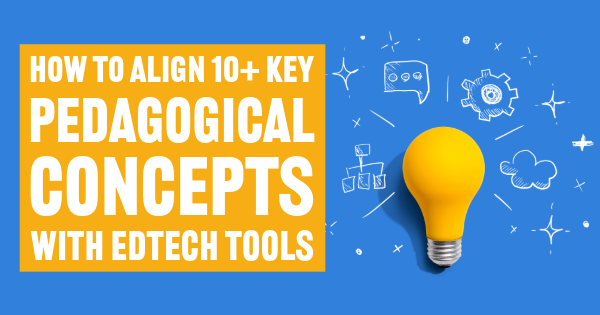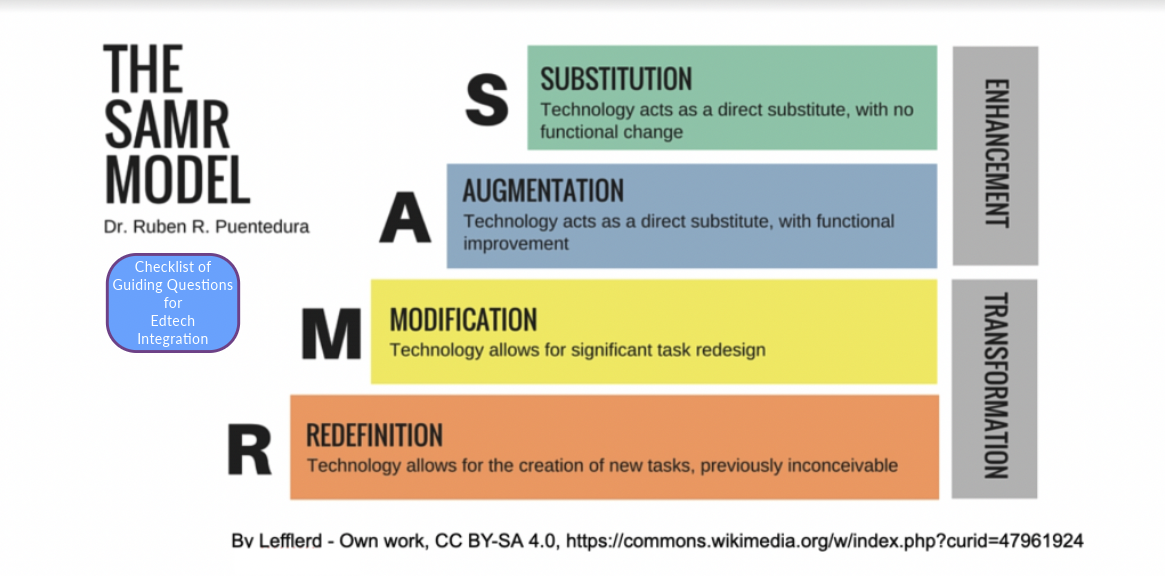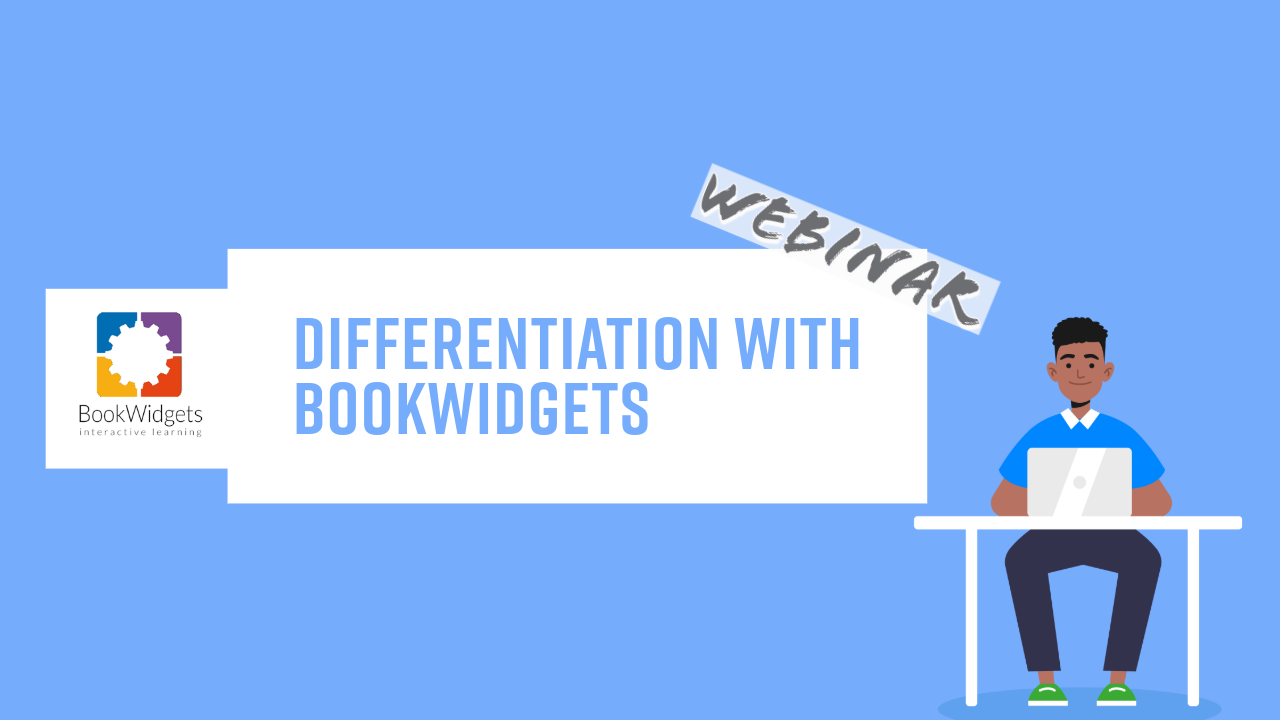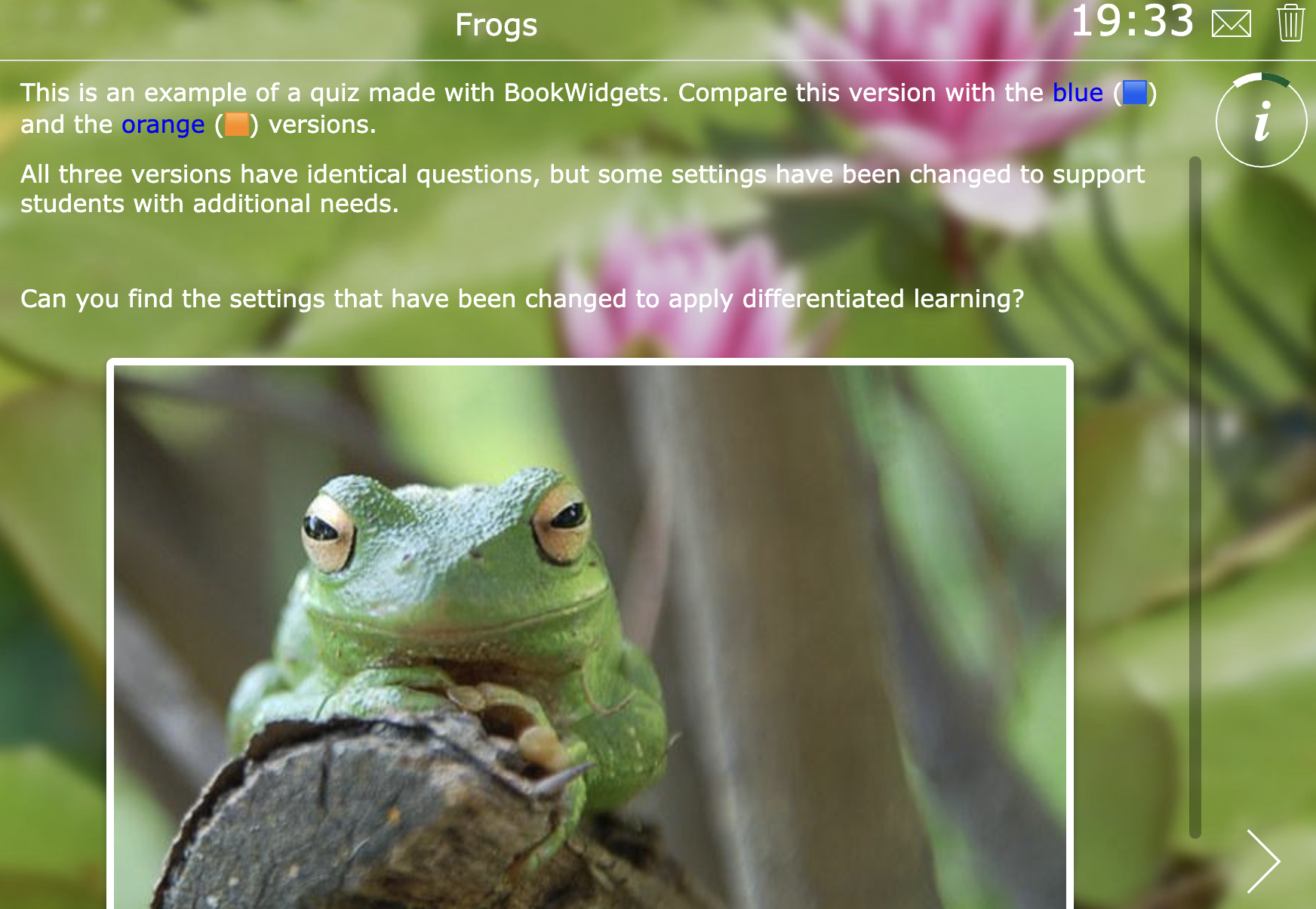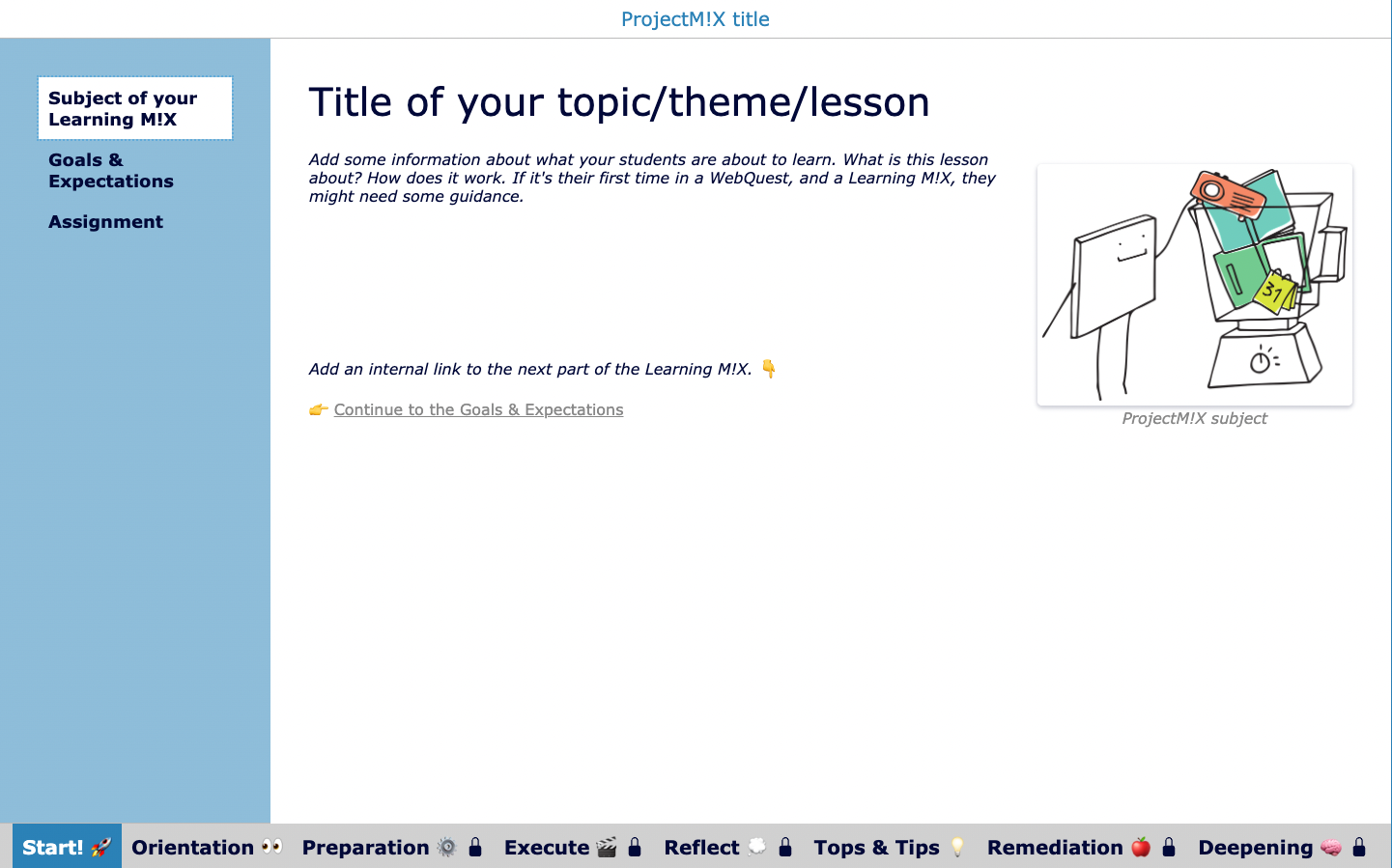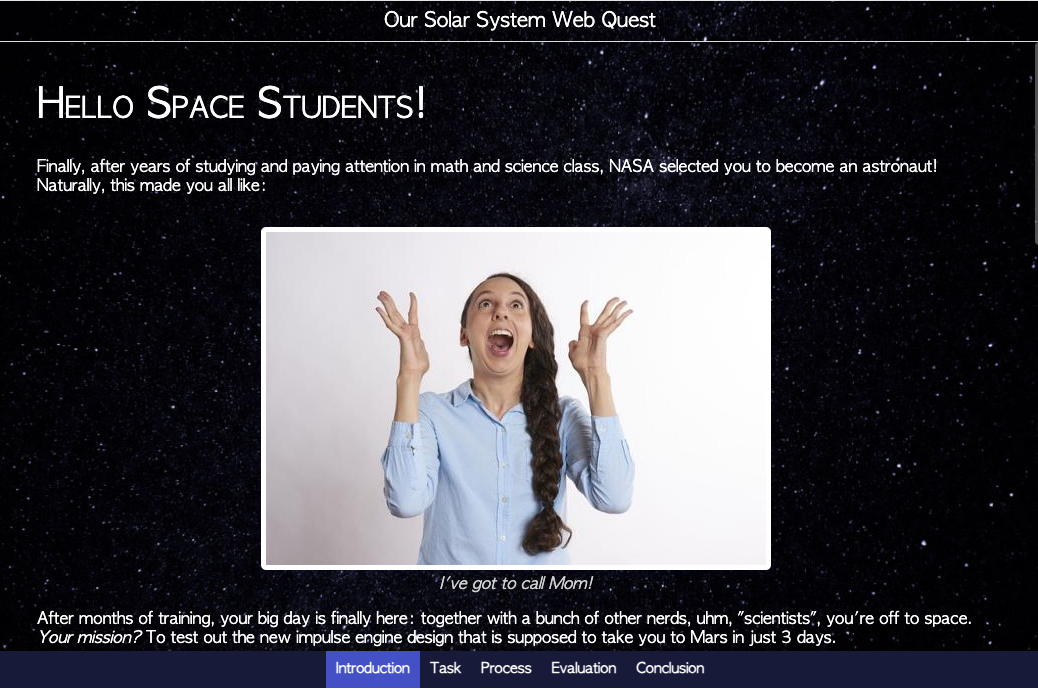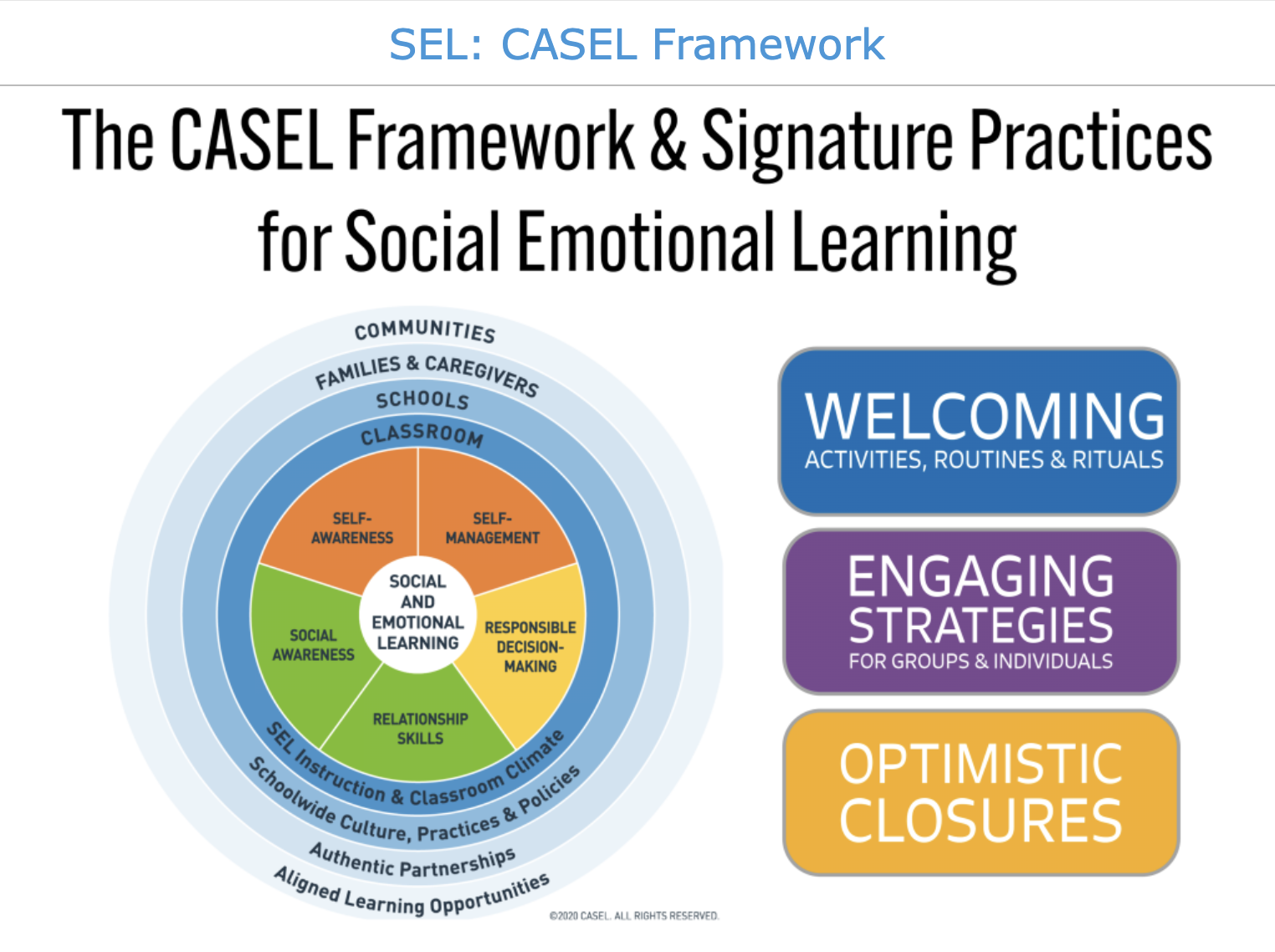10+ Essential Pedagogical Concepts and How to Apply Them With EdTech Tools
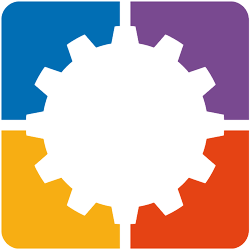 Kate Baker, Dimitri Bongers —
Kate Baker, Dimitri Bongers —
In today’s rapidly evolving educational landscape, educators face the challenge of integrating innovative EdTech tools and pedagogical methodologies to enhance student learning experiences. From Bloom’s Taxonomy to Project-Based Learning and everything in between, educators are continuously exploring diverse pedagogical frameworks to optimize teaching practices and foster student success.
In this guide, we will examine 12 key pedagogical principles. We’ll explore how these principles empower educators to create dynamic learning environments and cater to diverse student needs. For each pedagogical concept, we will provide ready-made lesson examples made with BookWidgets, and we’ll mention other EdTech tools that can be used for applying each specific pedagogical principle.
For educators who may be new to BookWidgets, it’s a user-friendly content creation and evaluation platform for teachers. With BookWidgets, educators can access 40+ customizable widgets, including quizzes, crossword puzzles, memory games, and more, all designed to enhance student engagement, comprehension and feedback.
You can read this blog post from top to bottom, or click on an educational concept you want to learn more about to jump straight to that section.
- Bloom’s Taxonomy
- SAMR
- UDL
- Formative assessment
- Differentiated instruction
- Self regulated learning
- Microlearning
- Blended learning
- Flipped learning
- Social emotional learning
- Project-based learning
- Standards Based Grading

1. Bloom’s Taxonomy
Bloom’s Taxonomy (by Benjamin Bloom) is a hierarchical model used to classify educational learning objectives into levels of complexity and specificity. It consists of six levels, starting from simple recall (remember), progressing to understanding, applying, analyzing, evaluating, and culminating in creating. The taxonomy helps educators design learning activities and assessments that target different cognitive skills, encouraging deeper understanding and critical thinking among students.
⚙️ Connection to BookWidgets
Teachers can leverage BookWidgets’ educational technology to address various levels of Bloom’s Taxonomy. For instance:
- Remember: Recall facts and information with flashcards or quizzes
- Understand: Explain concepts using widgets with multimedia elements like the Before & After, and the Spot the difference widgets.
- Apply: Have students solve problems or apply knowledge to real-world scenarios with specific questions in a Worksheet, or a list of tasks in a Checklist.
- Analyze: Have students compare, contrast, or analyze information with the Chart or Spreadsheet widgets.
- Evaluate: Require students to make judgments or give feedback with widgets like a Mindmap or an Exit slip.
- Create: Encourage students to generate original content, such as digital projects or multimedia presentations, demonstrating synthesis and creativity. The (Split) Whiteboard widget allows them to express all their creativity.
The above examples show that BookWidgets offers digital learning tools for each of the six levels in Bloom’s Taxonomy. Read this previous blog post for even more examples and further explanation on how you can apply the 6 levels of Bloom’s Taxonomy with EdTech tools like BookWidgets.
🔎 Examples in BookWidgets
Remember:These Flash cards help student to recall key vocabulary and definitions for a Geography course. Flash cards present key facts or concepts on one side and prompt learners to recall them from memory on the other side.
Understand: This Before & After widget for History helps students understand the evaluation of a situation (in this example, Europe before and after WWI). They can easily analyze and compare the two images.
Apply: This Worksheet features a science lab where students apply their prior knowledge to complete the experiment. The assignment is divided into several intermediate steps so that the teacher can always closely monitor the learning process.
Analyze: In this Chart students must collect data, visualize it on a graph and analyze it. The Chart prompts students to interpret and organize data to draw conclusions and make inferences, fostering advanced thinking skills.
Evaluate: In this Exit ticket students answer two simple questions. This allows the teacher to know immediately if the student has understood the lesson and can articulate and justify their opinion on the topic.
Create: A WhiteBoard widget gives your students a lot of freedom to develop their creative ideas related to the lesson topic.
📲 Other EdTech tools that align with Bloom’s Taxonomy
For each step in Bloom’s Taxonomy, there are numerous EdTech tools you can use with your students. Here are a few examples:
- Remember: Quizlet, Brainscape, Cram, …
- Understand: Google Maps, Genially, SeeSaw, …
- Apply: PhET Interactive Simulations, Pixton, …
- Analyze: Canva’s Graph Maker, MindMeister, …
- Evaluate: Poll everywhere, Mentimeter, …
- Create: Canva, Book Creator, Soundtrap, Google Docs, Flip, Adobe, …

2. SAMR Model of Edtech Integration
The SAMR Model of Technology Integration introduced by Reuben Puentdura (2006) is a 4-level taxonomy (often referred to as a ladder) used to select, utilize and evaluate technology in the PreK-12 classroom. This progressive framework guides educators through four distinct levels–Substitution, Augmentation, Modification, and Redefinition–in leveraging technology to enhance and transform learning in PreK-12 education. This pedagogical model encourages educators to progressively integrate digital tools into their teaching practices, moving from mere substitution to completely transforming the educational experience, thereby improving student engagement and learning outcomes.
⚙️ Connection to BookWidgets
Integrating BookWidgets with the SAMR model exemplifies how technology can both enhance and transform educational practices. At the Substitution and Augmentation levels, BookWidgets upgrades traditional educational tools by offering auto-scored digital quizzes and interactive learning materials, enhancing functionality and increasing efficiency. Teachers can easily apply these first steps of the SAMR model by digitizing their existing paper hadouts. At the more advanced stages of Modification and Redefinition, BookWidgets introduces revolutionary forms of learning and assessment. It enables educators to design dynamic, interactive assignments that integrate smoothly with educational platforms like Google Classroom and Microsoft Teams, promoting deeper student engagement and enriched learning experiences. For more information, check out this blog post: What is the SAMR Model of Technology Integration?
🔎 Examples in BookWidgets
Explore the SAMR model and sample BookWidgets activities in this Hotspot widget.
📲 Other EdTech tools you can use to apply the SAMR model
To do: below is just a draft. Improve and add links
Here are examples of other educational technology tools for each step:
- Substitution:
- Microsoft Word or Google Docs replacing traditional pen and paper.
- PowerPoint, Google Slides, or Genially for traditional slide presentations.
- Khan Academy videos replacing in-person lectures.
- Augmentation:
- Adding comments and collaboration features in Google Docs.
- Using interactive whiteboards (e.g., Zoom Whiteboards, Miro or Lucid Chart) instead of physical ones.
- Utilizing multimedia elements (images, audio, video) in presentations (e.g., Prezi, Genially).
- Modification:
- Collaborative editing and real-time collaboration in Google Docs.
- Creating digital portfolios using platforms like Seesaw or Google Sites.
- Using virtual reality (VR) simulations for immersive learning experiences (e.g., Google Expeditions).
- Redefinition:
- Conducting virtual field trips through VR experiences (e.g., Google Expeditions).
- Participating in global collaborative projects using platforms like Empatico, e-Twinning, or Go Pangea.
- Engaging in project-based learning with real-world applications using tools like Minecraft Education Edition or Scratch.

3. Universal Design for Learning
Universal Design for Learning (UDL) is a progressive educational framework that enhances accessibility and inclusivity in learning environments. It emphasizes the creation of flexible educational offerings that cater to a diverse range of learning preferences and abilities, ensuring that all students have equal opportunities to succeed. By focusing on providing multiple means of engagement, representation, and expression, UDL helps to dismantle barriers to learning, aiming to optimize teaching outcomes across different demographics and learning styles.
⚙️ Connection to BookWidgets
BookWidgets effectively supports the Universal Design for Learning (UDL) framework by providing educators with a suite of customizable digital tools that cater to the varied educational needs of students. With options for creating engaging content in formats like text, audio, and video, BookWidgets enhances learner engagement and supports diverse learning modalities. Teachers can create interactive lessons, quizzes, and games tailored to individual learning preferences and accessibility needs by customizing the content and settings of their digital learning activities. Check out these blog posts to learn more:
- 20+ Tips and Tools to Make Your Interactive Exercises Accessible to all Learners
- 10 Strategies to Create Inclusive Learning Environments - Empowering Equity in EdTech.
🔎 Examples in BookWidgets
This Quiz example is set up with accessibility features so that students can listen to audio and use text to speech and screenreaders to answer the questions.
This Worksheet features an embedded simple or scientific calculator, scratch pad, and onscreen keyboard that can help students answer the math questions. These features are enabled in the General tab when editing a widget activity.
This Pair Matching game also features audio and text to speech accessibilty features, making it accessible to visually impaired students.
📲Other EdTech tools that align with Universal Design for Learning
Edtech tools that include accessibility features enable all students with diverse needs to learn in a supportive digital environment. In addition to the accessibility features in BookWidgets, teachers can check out texthelp and Microsoft’s Immersive Reader to align with UDL principles.

4. Formative Assessment
Formative assessment is an ongoing process used by educators to gather information about students’ understanding and learning progress during instruction. Unlike summative assessment, which evaluates learning at the end of a unit or course, formative assessment occurs throughout the learning process. It provides feedback to both teachers and students, guiding instruction and helping learners identify areas for improvement. Formative assessments can take various forms, such as quizzes, discussions, observations, or informal checks for understanding, and are aimed at promoting student growth and deeper understanding rather than assigning grades.
⚙️ Connection to BookWidgets
Teachers can utilize BookWidgets for formative assessment in several ways:
- Formative Worksheets & Quizzes: Teachers can choose between over 30 interactive question types that are auto-graded: this makes formative assessments more engaging for students and teachers. There’s even a rubric question type! In addition, there are numerous options that allow the quiz or worksheet to be set up so that the student receives feedback very quickly, and even the option of a second attempt.
- Educational games: Educational games like crossword puzzles, memory games, and pair matching, serve as engaging tools for formative assessment. These games facilitate active learning, allowing students to apply knowledge while receiving instant feedback. As those games auto-correct, students can identify strengths and areas needing improvement.
- Exit tickets: BookWidgets’ Exit tickets offer a quick method for assessing students’ understanding at the end of a lesson. These exit slips allow individual reflection and feedback, providing teachers with valuable data for future instruction.
- Live widgets: Live teacher support and monitoring allow the teacher to provide differentiated instruction to struggling and advanced learners alike. Learn more about Live Widgets in this previous blog post.
BookWidgets contains different digital tools for Formative evaluation and offers teachers different assessment strategies allowing them to apply data-driven instruction for future assignments. Read this previous blog post for even more examples and further explanation on how you can apply Formative evaluation with EdTech tools like BookWidgets.
🔎 Examples in BookWidgets
The quiz and worksheet in BookWidgets have more than 35 different question types and plenty of options to customize them to your and your students’ needs. This Quiz example is set up so that students must work question by question (they cannot skip questions) and the answers are shown after each question.
Educational formative assessment games like this Crossword puzzle are perfect for practicing a variety of skills. Most of the digital educational games are automatically graded. Students will receive instant feedback.
In this Pair Matching game, students have to combine pictures and words. This allows the teacher to know immediately if the student has understood the lesson.
📲 Other EdTech tools that can be used for formative assessment
There are plenty of online tools you can use for formative testing, including Google Forms, Kahoot!, Nearpod, Padlet, Peard Deck, and more.
Check out this blog post from Shake up Learning for a more extensive list of formative assessment tools for your classroom.

5. Differentiated Instruction
Differentiated instruction is an approach to teaching that acknowledges and accommodates students’ diverse learning needs, interests, and abilities. It involves tailoring instruction, content, and assessments to match individual students’ readiness, learning preferences, and interests. Teachers may vary the content, process, product, or learning environment to meet the needs of all learners, ensuring that each student receives instruction at an appropriate level and pace. This approach maximizes each student’s learning potential by providing personalized support and challenges, individualized instruction, and adaptive learning methods.
⚙️ Connection to BookWidgets
Teachers can apply the concept of Differentiated instruction when using BookWidgets by:
- Customizing content: Create widgets with varied levels of difficulty or complexity to match different students’ levels. Teachers can make certain tools such as a calculator, spelling corrector, and text-to-speech available to students with additional needs.
- Offering choice: Provide students with options for engaging with content, such as different types of widgets to cater to diverse learning preferences.
- Adapting pacing: Allow students to work at their own pace by assigning BookWidgets activities asynchronously, enabling them to progress according to their readiness and learning speed.
- Scaffolding learning: Use BookWidgets to provide additional support or challenges as needed, guiding students through the learning process and ensuring they succeed at their own level.
- Personalizing feedback: Use BookWidgets’ features to provide individualized feedback based on students’ responses and progress, addressing their specific learning needs.
The above examples show that BookWidgets contains different features and options that allow teachers to differentiate their lessons. For even more examples and further explanation on how you can apply Differentiated Instruction with EdTech tools like BookWidgets check the following blog post or click on the image below to watch a full webinar on this topic.
- 40+ Innovative Ways Teacher Can Digitally Differentiate Their Lessons With BookWidgets
- 20 ways teachers can give differentiated instructions to students
- Digital differentiation examples with BookWidgets
🔎 Examples in BookWidgets
Below are three versions of a quiz with different question types. All three versions have identical questions, but the settings have been configured differently to support students with additional needs. Compare the three versions and try to find all the 10+ differences in the settings of this quiz to support students with additional needs. Afterwards, you can open the checklist to see if you found all the differences.
- Click here for the yellow version
- Click here for the bleu version
- Click here for the orange version
- Click here to check if you could find all the differences between the three versions.
📲 Other EdTech tools that allow Differentiated Instruction
Differentiated learning is a broad term and it can be applied in a variety of ways. Therefore, the list below is by no means exhaustive, but does provide some suggestions for EdTech tools that support differentiated instruction:
- Most LMSs such as Google Classroom and Microsoft Teams offer the possibility to give assignments to a selection of students (instead of publishing them to the entire class);
- Content platforms such as Khan Academy or Newsela usually have enough content available to give students customized videos or texts according to their level.
- There are an increasing number of EdTech tools that support adaptive learning, e.g. Wooflash, Reading progress and Prodigy.
- For students with additional reading needs, be sure to check out the possibilities of Microsoft’s Immersive reader (available in the Edge browser).
- For students who are still learning your language, help them by installing the Google Translate Chrome extension.

6. Self-regulated learning
Self-regulated learning (SRL) refers to the ability of learners to take control of their learning processes, including setting goals, monitoring progress, and adjusting strategies to achieve those goals. It involves metacognitive skills such as planning, self-monitoring, reflection, and the regulation of motivation and emotions. Self-regulated learners actively engage in their learning, seeking out resources and strategies to support their progress and taking responsibility for their learning outcomes. This approach fosters autonomy, independence, and lifelong learning skills.
⚙️ Connection to BookWidgets
In Self Regulated Learning, students are not meant to be left to their own devices. Teachers provide support, structure, guidance and feedback in the learning process. In BookWidgets, they can offer this framework to students using a Planner or Webquest, which students can use as a reference. A great example of this is the LearningM!X WebQuest we developed as part of the INSTALL-ed project. It’s sort of a template that you can use for SRL projects. Read more about it in this blog post and click on the image below to discover the SRL template (the passwords in some parts of this ProjectM!X are always 0000).
📲 Other EdTech tools that allow Self-regulated learning
As part of SRL, students can of course use all the tools that are also used for Formative Learning and Microlearning. As students take more and more control of their own learning, it is useful to let them work with an online portfolio tool such as SeeSaw, or let them explore planning tools such as MyStudyLife, Trello or Google Calendar.

7. Microlearning
Microlearning) involves delivering small, focused units of learning content that can be quickly consumed and easily digested by learners. Typically lasting a few minutes or less, micro-learning modules are designed to target specific learning objectives or skills. They leverage various formats, such as short videos, infographics, quizzes, or interactive activities, to deliver bite-sized chunks of information. Microlearning is characterized by its accessibility, flexibility, and efficiency, making it ideal for on-the-go learning and addressing immediate learning needs. It can be seamlessly integrated into daily routines, providing continuous learning opportunities without overwhelming the learner.
⚙️ Connection to BookWidgets
Teachers and students can apply the concept of microlearning using BookWidgets by incorporating various widget types that deliver small, focused units of content. Here are some examples:
- Flashcards: Create flashcard sets within BookWidgets to help students quickly review key concepts, vocabulary, or equations in bite-sized chunks.
- Quizzes: Design short quizzes with multiple-choice or short-answer questions to assess understanding of specific topics or learning objectives.
- Pair matching and memory games: Use matching exercises to reinforce associations between concepts, definitions, or images, promoting active recall and retention of information.
- Create video quizzes that combine short video clips with embedded questions or interactive elements. Students watch the brief video segment and then respond to related questions, promoting active engagement with the material and facilitating learning in bite-sized increments.
- Split Worksheets with embedded (TikTok) Videos: In a split worksheet, typically, one side of the layout contains instructional content, such as text, images, videos, or embedded media like TikTok videos. The other side provides interactive questions. This format integrates multimedia learning with interactive assessment, providing students a dynamic microlearning experience promoting active engagement and comprehension. Read our previous blog post to learn more about interactive micro-learning with TikTok videos.
- Exit tickets serve as microlearning by prompting students with concise, targeted questions or tasks at the end of a lesson to quickly assess comprehension, reinforce key concepts, or prompt reflection. Students engage in brief, focused activities that consolidate learning, promote retention, and provide immediate feedback, facilitating effective microlearning experiences in a compact format. Find 60+ ready-to-use exit tickets in our previous blog post.
By incorporating these microlearning-oriented widget types into BookWidgets, teachers can provide students with accessible, engaging, and efficient learning experiences tailored to fit into their busy schedules and learning preferences. Read this previous blog post to learn more about the benefits of Microlearning with EdTech tools like BookWidgets.
🔎 Examples in BookWidgets
These Flash cards help student to recall key vocabulary and definitions for a Geography course. Flash cards present key facts or concepts on one side and prompt learners to recall them from memory on the other side.
In this Geography Quiz, students learn about the Summer Solstice. This example is set up so that students see the correct answers after each question.
This Pair Matching game is an example of how English-Language Learners (ELL) can discover or practice English idioms in less than 2 minutes.
In this 3-minute video quiz for a Physics lesson, students learn about gravity. the video pauses automatically at the moments where the teacher has inserted questions.
This Split Worksheet is an example of a microlearning lesson with a TikTok video. Students watch the video ans answer a few short questions.
In this Exit ticket students answer two simple questions. This allows the teacher to know immediately if the student has understood the lesson and can articulate and justify their opinion on the topic.
📲 Other EdTech tools that allow microlearning
Many of the well-known EdTech tools can be used for microlearning if the teacher chooses to provide the content in small chunks. In addition, the following tools are absolutely focused on providing small units of learning content:

8. Blended Learning
Blended learning, a modern educational strategy, merges traditional classroom teaching with digital learning tools to create a flexible and personalized learning experience. This hybrid learning approach supports both synchronous interactions, such as live online classes, and asynchronous activities, like recorded lectures and digital assignments, allowing learners to study at their own pace and on their own schedule. Blended learning enhances student engagement by integrating diverse educational technologies and methods, making it possible to tailor learning experiences to individual preferences and needs. The effectiveness of blended learning is evident in its ability to increase student engagement and provide educators with actionable insights into student performance through real-time data analytics.
⚙️ Connection to BookWidgets
In the context of blended learning, BookWidgets is a pivotal tool by offering versatile functionalities that bridge the gap between in-person and online education. BookWidgets’ compatibility with popular learning management systems, including Google Classroom, Microsoft Teams, and Moodle, facilitates a seamless integration of digital and classroom activities with real-time data analytics. BookWidgets empowers educators to design interactive and personalized learning experiences that can dynamically adapt to varied educational needs. It enhances the blended learning environment by providing tools for real-time monitoring of student progress, personalized feedback, and the ability to adjust educational content based on individual student performance, ensuring a more effective and responsive educational experience.
If you want to explore the possibilities of blended learning with BookWidgets and are looking for inspiration, we definitely recommend these blog posts:
- What is blended learning? Apps for the perfect blended course
- How to Monitor Student Progress with Live Widgets - The Complete Teacher Guide
- 40+ Fun Activities you can Digitalise for your Classroom
🔎 Examples in BookWidgets To see blended learning in action, check out this Solar System WebQuest widget activity that not only delivers content and instructional digitally, but also gets students working in teams to collaborate on tasks.
📲 Other EdTech tools that allow blended learning
Any and every digital tool that teachers can use to create content for students and capture learning with students can be used for blended learning. Tools like Adobe Express, Canva, mmhmm, Prezi, and Genially empower teachers to become digital content creators. Learning management systems like Google Classroom, Microsoft Teams, Moodle, and Canvas can become the central hub of the digital learning environment for managing student workflow and content delivery, and digital content becomes actionable for students with tools like Quizlet, Formative, Flip, and more!

9. Flipped Learning
Flipped Learning (or the Flipped Classroom) redefines traditional educational methods by utilizing video and other digital media to introduce new content. In this innovative approach, students initially engage with material through video lectures and online resources at their own pace, rather than traditional in-class teaching. This transformative method prioritizes interactive, hands-on classroom experiences such as collaborative problem-solving, dynamic discussions, and practical applications of the material. By shifting the focus from passive to active learning, Flipped Learning enhances student engagement and fosters a deeper understanding of course content.
The goal of Flipped Learning is to make the best use of face to face time with students and colleagues by…
✅ Empowering students to learn at their own pace
✅ Making class time for problem-solving, discussion, and project-based learning
✅ Curating and reusing content for ongoing, personalized instruction
✅ Providing opportunities for meaningful, individualized instruction and timely feedback
With flipped learning, teachers are no longer the “sage on the stage” and instead are the “guide on the side”. To explore further about Flipped Learning strategies and tools, you can check out this detailed guide: The 5 Most Important Questions about Flipping the Classroom with Edtech.
⚙️ Connection to BookWidgets
The Video Quiz widget is an ideal tool for facilitating Flipped Learning! This widget supports the creation of diverse, multimedia learning pathways with 36 different question types, including 30 that are auto-scored, allowing educators to efficiently measure student comprehension. Teachers can also include short videos directly into specific questions and other widget-types as part of instructions enriches the learning experience, providing students with visual and auditory guidance. By integrating BookWidgets in Flipped Learning strategies, teachers can transition from traditional lecturers to facilitators of student-centered learning, offering personalized instruction and immediate feedback that caters to individual learning styles.
🔎 Examples in BookWidgets
This Video Quiz assesses students’ understanding of fractions at various points. Notice how seeing the teacher in the video impacts the viewing experience.
In this Worksheet, a video is embedded in a text question for students to view. Additional questions are added to check their understanding.
This Quiz features a teacher-created video modeling how to annotate a text and includes various questions for students to upload a picture of their work and check their understanding.
In this Split Worksheet students can find what they need all in one place with a video and resources on one side and the questions on the other.
On this Split Whiteboard students view a video of the water cycle and then use the provided tools to draw a diagram in the space provided.
A WebQuest with embedded videos and resources is great for extensive lessons and allows the teacher to curate everything students may need in one place.
📲 Other EdTech tools that allow Flipped Learning
Google Slides, Genially, and Edpuzzle are all tools that can used for flipped learning. Check out this blog post with 20 engaging flipped learning apps for in the flipped classroom.

10. Social Emotional Learning
Social emotional learning (SEL) is an educational process aimed at helping students develop critical skills for emotional and social functioning.The focus is not only on academic success, but also on building a foundation for better psychological well-being, improved interpersonal skills, and effective stress management.
CASEL, the Collaborative for Academic, Social, and Emotional Learning, defines social emotional learning (SEL) as “the process through which all young people and adults acquire and apply the knowledge, skills, and attitudes to develop healthy identities, manage emotions and achieve personal and collective goals, feel and show empathy for others, establish and maintain supportive relationships, and make responsible and caring decisions.”
The CASEL framework is a guide for making SEL an actionable part of human development and education with five core competencies that can be incorporated into daily lessons: Self Awareness, Self Management, Responsible Decision Making, Social Awareness, and Relationship Skills.These five core competencies are interwoven into everything teachers and students do in the classroom, and you can easily weave them together with your subject area content with CASEL’s three signature practices for incorporating SEL into the beginning, middle, and end of lessons:
- Welcoming Activities, Routines & Rituals that build community and connects to the work ahead
- Engaging Strategies that offer opportunities that vary in complexity for individual and collective learning
- Optimistic Closures that highlight individual and shared understandings, provide a sense of accomplishment, and support forward-thinking
Educators can integrate SEL into school curriculums using a variety of strategies, including direct teaching of skills, embedding practices within academic teaching, and fostering a positive school climate that promotes safety and respect. By modeling and promoting SEL in the classroom on a daily basis, teachers can create a positive and supportive learning environment that benefits all students.
⚙️ Connection to BookWidgets
With BookWidgets, teachers can create digital social emotional learning activities that directly teach social emotional skills, as well as digital activities that reinforce social emotional learning within the study of curricular content.
Explore this Hotspot Image widget to explore social emotional learning and see example digital SEL activities for each piece of CASEL’s framework and signature practices. Then check out this blog post which has 10 Creative and Ready to Use Social Emotional Learning Activities to Use in Class that were made with BookWidgets.
📲 Other EdTech tools for SEL
It is easy to tap into students’ social emotional skills when using educaitonal technology tools. Whether you want to check in on students’ emotional wellbeing or have them practice responsible decision making and collaboration skills, the use of just about any edtech tool can be aligned to CASEL’s framework and students’ social emotional learning needs. Here are 9 Good Social Emotional Learning (SEL) Apps to Transform Student Well-Being. Also check out Empatico, Sown to Grow, and MindUP for even more resources.

11. Project Based Learning with STEM
Project-Based Learning (PBL) offers an effective strategy for integrating STEM (Science, Technology, Engineering, and Mathematics) and STEAM (adding Art) principles into education, fostering real-world applications and interdisciplinary problem-solving. In these environments, students engage in complex, hands-on projects that challenge them to apply STEM knowledge practically. This approach boosts skills in critical thinking, problem-solving, and collaboration, and closely mirrors the complexities of real-life STEM / STEAM challenges. By leveraging technology and encouraging scientific inquiry, PBL not only deepens understanding but also equips students with essential skills for future technological and scientific careers. This pedagogical method highlights the relevance of STEM / STEAM education in preparing students for a rapidly evolving technological landscape. To learn even more about project based learning, visit PBLWorks by the Buck Institue for Education.
⚙️ Connection to BookWidgets
BookWidgets is a powerful ally in the realm of STEM/STEAM project-based learning, providing educators with a suite of tools to enhance the creation and delivery of interactive, technology-integrated educational projects. The use of specific widgets like Timeline, WebQuest, and Quiz enables students to dynamically explore and present STEM concepts. For instance, the Timeline widget is perfect for mapping out the progression of scientific discoveries or engineering projects, while the WebQuest widget supports thorough investigations into complex scientific or technological problems. Furthermore, the Quiz widget facilitates ongoing learning and assessment, which is crucial for mastering intricate STEM subjects. Additional widgets such as Checklists and Video Quizzes offer structured approaches to project tasks and multimedia assessments, thereby enriching the student learning experience and fostering a deeper engagement with STEM/STEAM content. These tools from BookWidgets help educators design more interactive, student-centered, and compelling learning environments, crucial for success in modern STEM education.
🔎 Examples in BookWidgets
This Video Quiz guides students through the process of creating a cotton ball launcher. Students take a picture of their project and upload it a Photo question to document each step of the project creation process.
In this Split Worksheet students interact with a PhET simulation on one side and answer questions on the right. Simulations are a great digital way for students to apply the concepts they’ve learned.
In this Worksheet, students follow the directions and answer the questions to complete a science lab activity on compound substances.
And check out these previous blog posts on PBL:
- What is project-based learning? 15 PBL ideas fit for your classroom
- How Teachers Can SCAMPER Their Way To Educational Innovation
- Interactive STEM lessons: engage learners with these 25 ready-to-use lesson ideas
📲 Other EdTech tools for PBL
There are numerous digital tools educators can use for Project Based Learning with STEM. Check out…
- PhET from the Unvisersity of Colorado which provides free simulations for Physics, Chemistry, Math, Earth Science, and Biology.
- CODE.org is a popular website for students to learn about coding and STEM-related fields.
- 19 Powerful Apps for Project-Based Learning

12. Standards Based Learning and Grading
Standards-based Learning and Grading is an educational approach that focuses on assessing students against consistent, predefined benchmarks for academic performance, as opposed to traditional grading systems that often compare students to each other. In a standards-based learning environment, activities and assessments are carefully designed to align with specific educational standards, ensuring that every aspect of student engagement and evaluation directly contributes to measurable learning objectives.
Here are several types of activities and assessments commonly used to demonstrate alignment with standards:
- Formative Assessments: Ongoing, quick assessments provide continuous feedback to both students and teachers about the learning progress. They help identify areas where students are struggling and allow for timely adjustments to teaching and learning strategies.
- Summative Assessments: These are typically more formal evaluations of student learning at the end of an instructional period, checking for mastery of the standards. They can take the form of tests, exams, final projects, or presentations that conclude a unit or course.
- Performance Tasks: These are complex challenges that mirror real-world issues and require students to apply various skills and knowledge to solve problems. Performance tasks are often interdisciplinary and designed to assess critical thinking, problem-solving, and application of knowledge in new contexts.
- Portfolios: Students compile a selection of their work over time which demonstrates growth and mastery of specific standards. Portfolios can include a variety of work such as writing samples, projects, and other assessments that collectively show the student’s understanding and skills.
Standards-based learning and grading ensures that grading is transparent and aligned directly with curriculum standards, emphasizing what students actually know and can do. For instance, standards-based grading breaks down subjects into specific skills and standards, allowing educators to provide precise feedback and support targeted learning improvements. Tools like digital rubrics can be pivotal in this approach, helping teachers to evaluate student work effectively against the educational standards. These rubrics facilitate clear, objective, and detailed assessments, enhancing both teaching strategies and student learning outcomes.
⚙️ Connection to BookWidgets
BookWidgets is a versatile tool that can significantly enhance standards-based learning and grading in the classroom. Teachers can create customized, interactive digital activities and assessments aligned to specific or multiple standards, depending on the learning objectives. When creating a widget activity, add resource information and links in the About section, and use rich-text formatting in Quizzes, Worksheets, Video Quizzes, or Split Worksheets to incorporate learning standards into each question, particularly allowing students to self-evaluate their achievement of standards in rubric questions. Whether monitoring students in real-time with Live Widgets or reviewing student work via the Reporting Dashboard, teachers can use the insights gained to tailor instruction and provide targeted support where needed, effectively fostering a personalized learning environment.
🔎 Examples in BookWidgets
In this Split Worksheet tagged with NJ Learning Standards for English Language Arts students read a text on one side and answer questions on the other.
In this Split Worksheet tagged with Next Generation Science Standards students interact with a virtual biology lab on one side and answer questions on the other.
This Worksheet is a writing activity for 4th grades that is aligned to the Common Core English Language Arts Wrtiting Standards for writing anrratives and includes a rubric question for students to self-assess their narrative.
📲 Other EdTech tools for Standards Based Learning and Grading
Some learning management systems, like PowerSchool, allow teachers to tag assignments with specific learning standards. Teachers can also use other tools such as IXL, TeacherEase, and Pear Deck to create standards-aligned assessments.
Wrap-up
As educators, we strive to integrate innovative approaches that foster student engagement, comprehension, and success. Through this guide, we’ve showcased how BookWidgets seamlessly aligns with different key pedagogical concepts, offering educators a comprehensive toolkit to elevate their teaching practices.
With a team comprised of former teachers, BookWidgets is uniquely positioned to understand the challenges and aspirations of educators worldwide. By embracing pedagogical principles and leveraging innovative technologies, we can create enriching learning experiences that inspire, motivate, and empower students to thrive in the 21st century and beyond.
Want to learn more about creating engaging lesson activities with BookWidgets?
✔️ Follow BookWidgets on X / Twitter and LinkedIn and join our teacher community on Facebook!
✔️ And, be sure to connect with us (Kate and Dimitri) on LinkedIn! 👋
